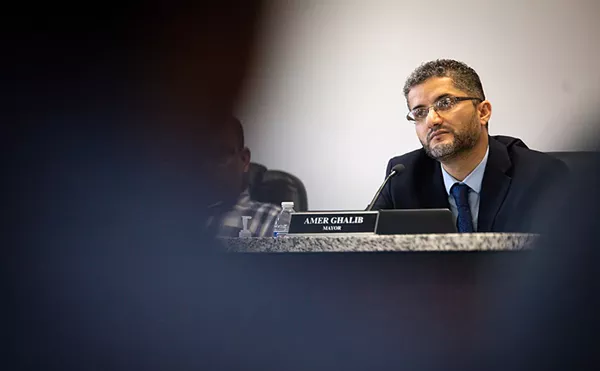If Detroit were a normal city, the Fire Department's dispatcher would have sent Engine Co. 47 first when reports started coming in Sept. 7, about fires breaking out around East Robinwood and Van Dyke. Engine 47 is only 1.3 miles away, and it's the closest rig to the scene with the ability to put water on a fire.
Detroit is not a normal city. It's especially not a normal city when it comes to fire. Engine 47 wasn't working Sept. 7: For budget reasons, officials make daily decisions to mothball rigs — and on Sept. 7, Engine 47 was among them, as it is almost every day.
So the closest rig wasn't available, and officials had to dispatch pumpers from farther away. Twenty-four structures in the East Robinwood area were damaged or destroyed in the firestorm that has rattled city residents and officials alike because, for a while, the fires seemed out of control.
Could Engine 47 alone have saved East Robinwood? No. Could a quicker response have made a difference? Yes.
The Sept. 7 firestorm produced lots of questions, but it is clear that the result — 71 damaged or destroyed houses in several neighborhoods and 29 families left homeless — lay bare, in spectacular fashion, the shortcomings of the Detroit Fire Department. The anarchic image, once again, of the Motor City burning underscored the public safety crisis that confronts the administration of Mayor Dave Bing, and it raised again the profound question of how a city with a shrinking budget can perform a city's basic task — protecting residents.
Detroit's battle-hardened firefighters in their torn, carbon-caked protective gear worked without rest for much of that night, but it wasn't enough. There weren't enough rigs or personnel, and the city was forced to seek help from suburban departments for the first time, according to Fire Commissioner James Mack, since the 1967 riot.
City officials blamed the fires on 50-mile-per-hour winds, dry conditions, illegal electrical hookups and brittle tree limbs that fell and brought down electrical wires. Mayor Bing said the fires resulted from "a natural disaster."
Windy days, though, are not that unusual in Detroit, nor are downed wires. Illegal electrical hookups, sadly, are common too, as impoverished families risk their lives to secure heat and light.
Dan McNamara, president of the Detroit Fire Fighters Association, attributed the extent of the destruction to the downsizing of the department. McNamara has been warning for years that because of cuts in rigs and manpower, the city "rolls the dice" every day, hoping the crazy randomness of fires never creates a situation that overwhelms the department.
Bing's predecessors reduced the number of rigs from 101, when Detroit was peaking in population in the 1950s, to 66 today. But there are never 66 rigs in service. Like Engine 47, as many as 10 rigs are sidelined daily because the city can't afford to keep the full fleet running.
On Sept. 7, Engine 47 and seven other rigs were idled, leaving 58 rigs, each with a crew of four. And, as usual, some rigs responded to fires despite equipment malfunctions, like ladder trucks whose mechanical ladders don't go up.
Trimming the fleet from 101 to 66 over 50 years might seem logical, given Detroit's population decline. But fires have increased as the population has gone down, in part due to increased poverty and abandonment. In recent years, Detroit has fought at least twice as many fires as in the 1950s, with a little more than half the number of working rigs and with the ranks of firefighters reduced by more than a one-third, from 1,650 down to 1,000 today.
'Natural disaster' or downsizing?
Like windy days, firestorms aren't that rare in Detroit. Slow-motion firestorms play out on a number of nights every year: Blazes ignite, by chance, at roughly the same time in scattered neighborhoods; multiple houses burn on the same block; and crews hustle to keep up. But few people notice. Recently, July 4, and the early morning of July 5, were abnormally busy, but the situation didn't surge out of control.
Fire statistics are hard to come by because the department has failed to publish an annual report for several years.
But Commissioner Mack said last week Detroit averages 35 fires a day. That is nearly 13,000 a year, or more than one an hour, and since most fires break out after dark, many of those 35 blazes are compressed into certain nighttime hours. Detroit firefighters are so busy at night, in fact, that they are allowed to nap in the afternoon.
No major American city burns like Detroit. New York, for example, had about 3 times as many fires as Detroit in 2009 — but with 10 times Detroit's population and many times more buildings.
Detroit also has a huge problem with arson fires. No one really knows how many, because there aren't enough investigators to look into every suspicious incident. In 2009, one arson squad supervisor estimated about a third of Detroit's fires are criminal in nature.
The last two firefighters killed on duty in Detroit were responding to arson fires. Firefighters crushed and critically injured last month by a falling wall of bricks also were working a deliberately set blaze.
How the firestorm came to be
It was probably an arson fire Sept. 7 that set in motion the events that resulted in the firestorm.
By 5 p.m. that day, rigs were busy responding to reports of downed wires and other routine incidents, but the workload was manageable.
Then a fire broke out in an abandoned, two-story commercial building on Chene and Hendrie that appeared to have nothing to do with that day's conditions. It quickly escalated into a second alarm. Ten rigs and three chiefs responded to that incident.
So by 5:30 p.m., 1 in 6 of the available rigs the city had on Sept. 7 had assembled in that one location, near the intersection of I-75 and I-94.
It was right about that time that reports started coming in about fires roaring out of control in the East Robinwood and Van Dyke area. At 5:35 p.m., when a chief called for a second alarm on East Robinwood, he told the dispatcher, "I have three dwellings and one garage and rubbish and possibly the whole block."
The department had to scramble. Almost all the rigs it found to send to the second alarm on East Robinwood were from the west side, and driving through rush-hour traffic to northeast Detroit lengthened their response times and allowed the fires to intensify.
A little while later, an officer on a ladder at the Moenart Street fires pleaded with the dispatcher, "We have four dwellings and a garage and it's going to be more than that in a minute."
About 20 minutes later, the same officer told the dispatcher, "I still need two engines."
And still later, his voice sounded sharp. "Have you sent the additional companies?" he demanded.
The dispatcher, who managed to keep a Zen-like equanimity throughout the night, told him, "We're working on those additional companies right now."
Examples of the department's dysfunction surfaced regularly.
At one point, a chief radioed in, saying he needed an additional ladder truck because the one on the scene, Ladder Co. 25, could not raise its tower.
At the fire station on West Alexandrine, near Cass, an officer from Ladder Co. 20 called for an engine to put out a small fire next door from downed wires. Ladder 20 carries enough water in its on-board reservoir to put it out. But its pump was broken that day.
What's the city to do?
The major problem in the Fire Department, like everywhere in city government, is lack of money. And the budget problem seems to be getting worse. Is there a point of no return with the Fire Department in a city that burns a lot? You can cut back on city accountants or tax clerks, and no one notices. You run out of fire rigs, and fires begin taking out neighborhoods, and a decent bureaucrat like Commissioner Mack — you have to feel sorry for him — is left to answer for consequences of chronically insufficient budgets.
What can we do? Is the solution a region-wide fire service, as in Toronto? The suburbs are overprotected, but would suburban residents give up their hometown departments? Budget problems in suburbia could become a big persuader.
Many fires take place in abandoned structures, as on Sept. 7. Will officials realize abandoned buildings are a public-health issue and treat them like the emergency they are?
Driving across the city, you cannot escape the way fire has scarred the landscape. And the scars are not just physical. I was returning from reporting for this column Saturday when I encountered a woeful man standing in the rain at Eight Mile and the Southfield Freeway. His sign about his family being homeless also gave a reason for their plight: "Because of a fire."
"Resurget cineribus," goes the city of Detroit motto. "It shall rise from the ashes."
Bill McGraw retired from the Detroit Free Press in September 2009. Send comments to [email protected]





